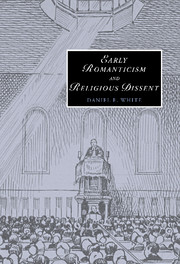Book contents
- Frontmatter
- Contents
- List of illustrations
- Acknowledgments
- Frequently cited texts
- Epigraph
- Introduction
- 1 “True Principles of Religion and Liberty”: liberal Dissent and the Warrington Academy
- 2 Anna Barbauld and devotional tastes: extempore, particular, experimental
- 3 The “Joineriana”: Barbauld, the Aikin family circle, and the Dissenting public sphere
- 4 Godwinian scenes and popular politics: Godwin, Wollstonecraft, and the legacies of Dissent
- 5 “Properer for a Sermon”: Coleridgean ministries
- 6 “A Saracenic mosque, not a Quaker meeting-house”: Southey's Thalaba, Islam, and religious nonconformity
- 7 Conclusion
- Notes
- Bibliography
- Index
- CAMBRIDGE STUDIES IN ROMANTICISM
6 - “A Saracenic mosque, not a Quaker meeting-house”: Southey's Thalaba, Islam, and religious nonconformity
Published online by Cambridge University Press: 22 September 2009
- Frontmatter
- Contents
- List of illustrations
- Acknowledgments
- Frequently cited texts
- Epigraph
- Introduction
- 1 “True Principles of Religion and Liberty”: liberal Dissent and the Warrington Academy
- 2 Anna Barbauld and devotional tastes: extempore, particular, experimental
- 3 The “Joineriana”: Barbauld, the Aikin family circle, and the Dissenting public sphere
- 4 Godwinian scenes and popular politics: Godwin, Wollstonecraft, and the legacies of Dissent
- 5 “Properer for a Sermon”: Coleridgean ministries
- 6 “A Saracenic mosque, not a Quaker meeting-house”: Southey's Thalaba, Islam, and religious nonconformity
- 7 Conclusion
- Notes
- Bibliography
- Index
- CAMBRIDGE STUDIES IN ROMANTICISM
Summary
While Coleridge's career as a nonconformist preacher was coming to a close, Robert Southey was sketching plans and carrying out research for Thalaba the Destroyer, a Metrical Romance (1801). In other words, as Coleridge was weighing the Wedgwood annuity against the Shrewsbury invitation, Southey was worrying that it would “not be easy to find a new way of destroying an enchanter's den.” “There will be much to avoid in this poem” (CPB, iv, p. 182), he predicted, and although Thalaba has had its ardent admirers, including Percy Bysshe Shelley and John Henry Newman, many of Southey's readers have wished that he had simply avoided the poem altogether. The reviewer for the British Critic sniped, “A more complete monument of vile and depraved taste no man ever raised”; the early-nineteenth-century reviewers had their reasons, as have critics in the twentieth century who have tended to dismiss the poem, and Southey, for being “unable to break through to the new consciousness that we call ‘Romantic,’ a consciousness frankly introspective, skeptical, and symbolistic.” Southey's apparent inability to “break through” to this “new consciousness” during his heterodox, radical, and Orientalist period provides an important opportunity. Expressing a monotheistic, intuitive, and active faith within the generic form of the quest romance, Southey's “failure” will let us address the ways in which religious heterodoxy, anti-sectarianism, and Enlightenment skepticism inform an anti-authoritarian and experimental poet's fraught engagement with a different religious system, that of Islam.
- Type
- Chapter
- Information
- Early Romanticism and Religious Dissent , pp. 152 - 181Publisher: Cambridge University PressPrint publication year: 2007
- 1
- Cited by



